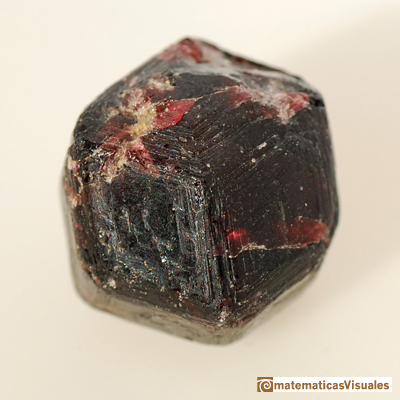- About MAA
- Membership
- MAA Publications
- Periodicals
- Blogs
- MAA Book Series
- MAA Press (an imprint of the AMS)
- MAA Notes
- MAA Reviews
- Mathematical Communication
- Information for Libraries
- Author Resources
- Advertise with MAA
- Meetings
- Competitions
- Programs
- Communities
- MAA Sections
- SIGMAA
- MAA Connect
- Students
- MAA Awards
- Awards Booklets
- Writing Awards
- Teaching Awards
- Service Awards
- Research Awards
- Lecture Awards
- Putnam Competition Individual and Team Winners
- D. E. Shaw Group AMC 8 Awards & Certificates
- Maryam Mirzakhani AMC 10 A Awards & Certificates
- Two Sigma AMC 10 B Awards & Certificates
- Jane Street AMC 12 A Awards & Certificates
- Akamai AMC 12 B Awards & Certificates
- High School Teachers
- News
You are here
Kepler and the Rhombic Dodecahedron: Introducing the Rhombic Dodecahedron
We now begin our study of the rhombic dodecahedron. This polyhedron is related to some deep questions in mathematics (for example, the Kepler Conjecture that is briefly presented later) as well as to other fields of science such as crystallography and chemistry. Yet, it is also a simple and beautiful polyhedron with a wonderful history that will engage anyone interested in mathematics and polyhedra.
The word polyhedron (plural polyhedra) comes from Greek and literally means “many faces.” In geometry, a polyhedron is any three-dimensional shape that has flat polygonal faces—which need not all be the same. The rhombic dodecahedron is a polyhedron with twelve equal faces that are rhombi.
The rhombic dodecahedron.
This polyhedron was discovered by the German astronomer and mathematician Johannes Kepler around 1600.
It is remarkable that there is no evidence that anyone before Kepler wrote about it. We can be sure that the shape of the rhombic dodecahedron was well known: a mineral called a garnet has been used since prehistoric times as a gemstone. It is beautiful, abundant, and cheap.
Figure 3. Garnet with the shape of a rhombic dodecahedron.
Nonetheless, it seems that mathematicians were not interested in this shape until Kepler. The most plausible reason for this may be that this polyhedron is not regular in the sense that interested Greek mathematicians. Its faces are rhombi, not regular polygons (that is, polygons that have equal sides symmetrically placed about a common center, such as an equilateral triangle), and it does not have only one kind of vertex—rather, some of its vertices have degree 3 and others have degree 4 (unlike the Platonic and Archimedean solids that we talk about later in this article).
The next section begins by looking at some basic facts about Kepler's life and times to put his discovery in an historical context. Following the topics discussed in Kepler’s publications, we then will study the rhombic dodecahedron from three different points of view: nature, technology, and art. Each theme will reveal some complementary properties of this polyhedron. Throughout this exploration of Kepler’s discovery, we will also see how mathematics itself is a subject that is continually being developed, with the creation of new mathematics continuing even today. For example, in the concluding section of this article, we will observe a few of the questions that Kepler asked about polyhedra which spurred additional discoveries in this field.
Roberto Cardil (matematicasVisuales), "Kepler and the Rhombic Dodecahedron: Introducing the Rhombic Dodecahedron," Convergence (March 2022)





